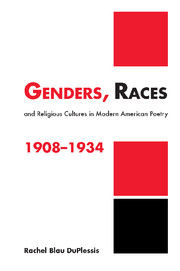Book contents
- Frontmatter
- Contents
- Acknowledgments
- 1 Entitled new: a social philology of modern American poetry
- 2 “Corpses of poesy”: modern poets consider some gender ideologies of lyric
- 3 “Seismic orgasm”: sexual intercourse, its modern representations and politics
- 4 “HOO, HOO, HOO”: some episodes in the construction of modern male whiteness
- 5 “Darken your speech”: racialized cultural work in black and white poets
- 6 “Wondering Jews”: melting-pots and mongrel thoughts
- Notes
- Works Cited
- Index
4 - “HOO, HOO, HOO”: some episodes in the construction of modern male whiteness
Published online by Cambridge University Press: 05 October 2009
- Frontmatter
- Contents
- Acknowledgments
- 1 Entitled new: a social philology of modern American poetry
- 2 “Corpses of poesy”: modern poets consider some gender ideologies of lyric
- 3 “Seismic orgasm”: sexual intercourse, its modern representations and politics
- 4 “HOO, HOO, HOO”: some episodes in the construction of modern male whiteness
- 5 “Darken your speech”: racialized cultural work in black and white poets
- 6 “Wondering Jews”: melting-pots and mongrel thoughts
- Notes
- Works Cited
- Index
Summary
BOOM, kill the Arabs.
BOOM, kill the white men,
HOO, HOO, HOO.
Vachel Lindsay, 1914And fears not portly Azcan nor his hoos.
Wallace Stevens, 1922Hoo ha ha
Hoo ha ha
HOO
HOO
HOO
T. S. Eliot, 1923–24This chapter undertakes an analysis of “Hoo”: a phonemic bit apparently decorative, unpurposeful, and wayward, resounding in poems of Vachel Lindsay, Wallace Stevens, and T. S. Eliot. Despite looking like a meaningless sound or inarticulate syllable, the phoneme presents a cornucopia of racialized materials in order to create a powerful position for [male] whiteness; it makes a vibrant, aggressive sound of threat and promise that thrills and jolts its users. This reading of a poetic phoneme by social philology proceeds “by fully semanticizing / the so-called nonsemantic features of language” (Bernstein 1992, 16). An alternative and important reading of “hoo” in Eliot only, one that helped incite this chapter, occurs in Michael North's work. He takes the syllable as an indicator of nullity, a “purely phatic sound” “associated with cultures outside of Europe” that Eliot uses to indicate that “language has become null” as Sweeney crosses the line, confessing the savagery of murder (North 1992, 69–70; 1994, 89, 96). In contrast, but helped considerably by North's focus, I see the sound as having content and intertextualities. Briefly to sketch some of its effects, “hoo” draws on black agency and autonomy, which, because mysterious, inexplicable, and frightening to Euro-American writers, is therefore paradoxically affirmed and denied in the syllable “hoo.”
- Type
- Chapter
- Information
- Publisher: Cambridge University PressPrint publication year: 2001



